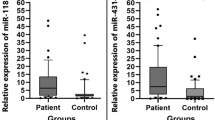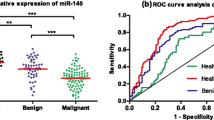Abstract
Ovarian cancer is the fifth leading cause of female death globally due to its low survival rates. Thus, improved approaches for ovarian cancer detection are urgently needed. MicroRNAs as a new class of biomarkers have been explored in recent studies. This study was trying to identify and validate the two kinds of serum microRNA (miR-200c and miR-141) as biomarkers for ovarian cancer. We extracted serum samples from 74 epithelial ovarian cancer patients, 19 borderline ovarian cancer, and 50 healthy controls. Relative expression of these miRNA markers were measured by quantificational real-time polymerase chain reaction assay (qRT-PCR). Receiver operating characteristics (ROC) and area under the ROC curve (AUC) were used to validate the diagnostic value of miR-200c and miR-141. Kaplan-Meier curve and the log-rank test were conducted to detect the prognostic value of miR-200c and miR-141. miR-200c and miR-141 were significantly elevated in the epithelial ovarian cancer patients compared to healthy controls. The relative expression level of miR-200c showed a descending trend from early stages to advanced stages, while the level of miR-141 displayed an escalating trend. Patients with high miR-200c level achieved significantly a higher 2-year survival rate compared with the other group (P < 0.001), while low miR-141 group showed a significantly higher survival rate. The results of the current study suggested that serum miR-200c and miR-141 were able to discriminate the ovarian cancer patients from healthy controls. In addition, miR-200c and miR-141 may be predictive biomarkers for ovarian cancer prognosis. Further large-scale studies are still needed to confirm our findings.






Similar content being viewed by others
References
Siegel R, Naishadham D, Jemal A. Cancer statistics, 2012. CA Cancer J Clin. 2012;62:10–29.
Duffy MJ, Bonfrer JM, Kulpa J, Rustin GJ, Soletormos G, Torre GC, et al. CA125 in ovarian cancer: European Group on Tumor Markers guidelines for clinical use. Int J Gynecol Cancer. 2005;15:679–91. doi:10.1111/j.1525-1438.2005.00130.x.
Badgwell D, Bast Jr RC. Early detection of ovarian cancer. Dis Markers. 2007;23:397–410.
Meany DL, Sokoll LJ, Chan DW. Early detection of cancer: immunoassays for plasma tumor markers. Expert Opin Med Diagn. 2009;3:597–605. doi:10.1517/17530050903266830.
Ueland FR, Desimone CP, Seamon LG, Miller RA, Goodrich S, Podzielinski I, et al. Effectiveness of a multivariate index assay in the preoperative assessment of ovarian tumors. Obstet Gynecol. 2011;117:1289–97. doi:10.1097/AOG.0b013e31821b5118.
Ware Miller R, Smith A, DeSimone CP, Seamon L, Goodrich S, Podzielinski I, et al. Performance of the American College of Obstetricians and Gynecologists' ovarian tumor referral guidelines with a multivariate index assay. Obstet Gynecol. 2011;117:1298–306. doi:10.1097/AOG.0b013e31821b1d80.
Hausler SF, Keller A, Chandran PA, Ziegler K, Zipp K, Heuer S, et al. Whole blood-derived miRNA profiles as potential new tools for ovarian cancer screening. Br J Cancer. 2010;103:693–700. doi:10.1038/sj.bjc.6605833.
Lee RC, Feinbaum RL, Ambros V. The C. elegans heterochronic gene lin-4 encodes small RNAs with antisense complementarity to lin-14. Cell. 1993;75:843–54.
Calin GA, Croce CM. MicroRNA signatures in human cancers. Nat Rev Cancer. 2006;6:857–66. doi:10.1038/nrc1997.
Zhang B, Pan X, Cobb GP, Anderson TA. microRNAs as oncogenes and tumor suppressors. Dev Biol. 2007;302:1–12. doi:10.1016/j.ydbio.2006.08.028.
Guo F, Tian J, Lin Y, Jin Y, Wang L, Cui M. Serum microRNA-92 expression in patients with ovarian epithelial carcinoma. J Int Med Res. 2013;41:1456–61. doi:10.1177/0300060513487652.
Peng WZ, Ma R, Wang F, Yu J, Liu ZB. Role of miR-191/425 cluster in tumorigenesis and diagnosis of gastric cancer. Int J Mol Sci. 2014;15:4031–48. doi:10.3390/ijms15034031.
Li T, Yin J, Yuan L, Wang S, Yang L, Du X, et al. Downregulation of microRNA-139 is associated with hepatocellular carcinoma risk and short-term survival. Oncol Rep. 2014;31:1699–706. doi:10.3892/or.2014.3032.
Puerta-Gil P, Garcia-Baquero R, Jia AY, Ocana S, Alvarez-Mugica M, Alvarez-Ossorio JL, et al. miR-143, miR-222, and miR-452 are useful as tumor stratification and noninvasive diagnostic biomarkers for bladder cancer. Am J Pathol. 2012;180:1808–15. doi:10.1016/j.ajpath.2012.01.034.
Wang Q, Huang Z, Ni S, Xiao X, Xu Q, Wang L, et al. Plasma miR-601 and miR-760 are novel biomarkers for the early detection of colorectal cancer. PLoS ONE. 2012;7:e44398. doi:10.1371/journal.pone.0044398.
Zhang T, Zhao D, Wang Q, Yu X, Cui Y, Guo L, et al. MicroRNA-1322 regulates ECRG2 allele specifically and acts as a potential biomarker in patients with esophageal squamous cell carcinoma. Mol Carcinog. 2013;52:581–90. doi:10.1002/mc.21880.
Lee JW, Park YA, Choi JJ, Lee YY, Kim CJ, Choi C, et al. The expression of the miRNA-200 family in endometrial endometrioid carcinoma. Gynecol Oncol. 2011;120:56–62. doi:10.1016/j.ygyno.2010.09.022.
Kan CW, Hahn MA, Gard GB, Maidens J, Huh JY, Marsh DJ, et al. Elevated levels of circulating microRNA-200 family members correlate with serous epithelial ovarian cancer. BMC Cancer. 2012;12:627. doi:10.1186/1471-2407-12-627.
Jemal A, Bray F, Center MM, Ferlay J, Ward E, Forman D. Global cancer statistics. CA Cancer J Clin. 2011;61:69–90. doi:10.3322/caac.20107.
Pectasides D, Pectasides E. Maintenance or consolidation therapy in advanced ovarian cancer. Oncology. 2006;70:315–24. doi:10.1159/000097943.
Sun Y, Wang M, Lin G, Sun S, Li X, Qi J, et al. Serum microRNA-155 as a potential biomarker to track disease in breast cancer. PLoS One. 2012;7:e47003. doi:10.1371/journal.pone.0047003.
Wei J, Liu LK, Gao W, Zhu CJ, Liu YQ, Cheng T, et al. Reduction of plasma microRNA-21 is associated with chemotherapeutic response in patients with non-small cell lung cancer. Chin J Cancer Res. 2011;23:123–8. doi:10.1007/s11670-011-0123-2.
Saito T, Saetrom P. MicroRNAs—targeting and target prediction. N Biotechnol. 2010;27:243–9. doi:10.1016/j.nbt.2010.02.016.
Peter ME. Targeting of mRNAs by multiple miRNAs: the next step. Oncogene. 2010;29:2161–4. doi:10.1038/onc.2010.59.
Gregory PA, Bert AG, Paterson EL, Barry SC, Tsykin A, Farshid G, et al. The miR-200 family and miR-205 regulate epithelial to mesenchymal transition by targeting ZEB1 and SIP1. Nat Cell Biol. 2008;10:593–601. doi:10.1038/ncb1722.
Taylor DD, Gercel-Taylor C. MicroRNA signatures of tumor-derived exosomes as diagnostic biomarkers of ovarian cancer. Gynecol Oncol. 2008;110:13–21. doi:10.1016/j.ygyno.2008.04.033.
Dodge JE, Covens AL, Lacchetti C, Elit LM, Le T, Devries-Aboud M, et al. Preoperative identification of a suspicious adnexal mass: a systematic review and meta-analysis. Gynecol Oncol. 2012;126:157–66. doi:10.1016/j.ygyno.2012.03.048.
Nam EJ, Yoon H, Kim SW, Kim H, Kim YT, Kim JH, et al. MicroRNA expression profiles in serous ovarian carcinoma. Clin Cancer Res. 2008;14:2690–5. doi:10.1158/1078-0432.CCR-07-1731.
Iorio MV, Visone R, Di Leva G, Donati V, Petrocca F, Casalini P, et al. MicroRNA signatures in human ovarian cancer. Cancer Res. 2007;67:8699–707. doi:10.1158/0008-5472.CAN-07-1936.
Meng F, Henson R, Lang M, Wehbe H, Maheshwari S, Mendell JT, et al. Involvement of human micro-RNA in growth and response to chemotherapy in human cholangiocarcinoma cell lines. Gastroenterology. 2006;130:2113–29. doi:10.1053/j.gastro.2006.02.057.
Wu W, Lin Z, Zhuang Z, Liang X. Expression profile of mammalian microRNAs in endometrioid adenocarcinoma. Eur J Cancer Prev. 2009;18:50–5. doi:10.1097/CEJ.0b013e328305a07a.
Chung TK, Cheung TH, Huen NY, Wong KW, Lo KW, Yim SF, et al. Dysregulated microRNAs and their predicted targets associated with endometrioid endometrial adenocarcinoma in Hong Kong women. Int J Cancer. 2009;124:1358–65. doi:10.1002/ijc.24071.
Yaman Agaoglu F, Kovancilar M, Dizdar Y, Darendeliler E, Holdenrieder S, Dalay N, et al. Investigation of miR-21, miR-141, and miR-221 in blood circulation of patients with prostate cancer. Tumour Biol. 2011;32:583–8. doi:10.1007/s13277-011-0154-9.
Mitchell PS, Parkin RK, Kroh EM, Fritz BR, Wyman SK, Pogosova-Agadjanyan EL, et al. Circulating microRNAs as stable blood-based markers for cancer detection. Proc Natl Acad Sci U S A. 2008;105:10513–8. doi:10.1073/pnas.0804549105.
Di Leva G, Piovan C, Gasparini P, Ngankeu A, Taccioli C, Briskin D, et al. Estrogen mediated-activation of miR-191/425 cluster modulates tumorigenicity of breast cancer cells depending on estrogen receptor status. PLoS Genet. 2013;9:e1003311. doi:10.1371/journal.pgen.1003311.
Cai H, Yuan Y, Hao YF, Guo TK, Wei X, Zhang YM. Plasma microRNAs serve as novel potential biomarkers for early detection of gastric cancer. Med Oncol. 2013;30:452. doi:10.1007/s12032-012-0452-0.
Conflicts of interest
None
Author information
Authors and Affiliations
Corresponding author
Rights and permissions
About this article
Cite this article
Gao, Yc., Wu, J. MicroRNA-200c and microRNA-141 as potential diagnostic and prognostic biomarkers for ovarian cancer. Tumor Biol. 36, 4843–4850 (2015). https://doi.org/10.1007/s13277-015-3138-3
Received:
Accepted:
Published:
Issue Date:
DOI: https://doi.org/10.1007/s13277-015-3138-3




